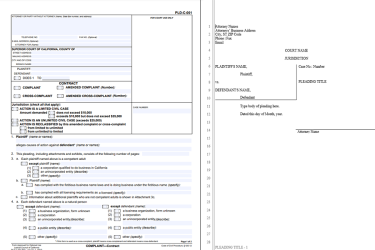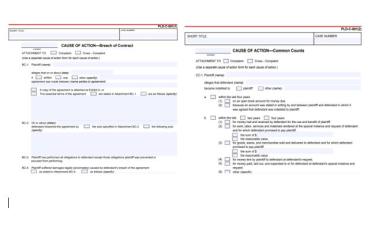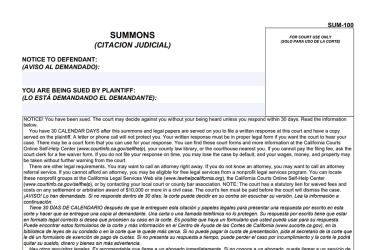What do these papers mean?
Summons (form SUM-100) and Complaint
If you receive a form called a Summons (form SUM-100) it means that someone is suing you in court. In addition to the Summons, you'll also receive another document, called a Complaint. The Complaint says why you are being sued.
Learn more about what the forms mean and what your choices are.

Who is suing me and what are they asking for?
The Complaint says who is suing you, why, and what they're asking for. The Complaint might be a form or typed up in a specific legal format where each line is numbered (called pleading paper).
- The plaintiff is who is suing you. They may have a lawyer listed on the paperwork.
- The defendant is you and anyone else that's listed.
The information about jurisdiction describes what kind of case it is, based on the amount of money the plaintiff is asking for. The amount of money the plaintiff is asking for is called damages. You may also see it described as the prayer amount. This is the amount the plaintiff says you owe. It can include costs to cover court fees and attorney's fees.

Why am I being sued?
The Complaint says the legal reason the plaintiff is suing you. This is called a cause of action. There must be at least one cause of action, and there can be more than one. Here are some common causes of action and a general description of what they mean:
-
Breach of Contract
You broke an agreement with the plaintiff and this hurt the plaintiff (usually, it's that it cost them money). A copy of the contract or the terms of the contract may be attached.
-
General negligence
You did not act reasonably and what you did hurt the plaintiff in some way.
-
Motor vehicle
You were driving or owned a car that hurt the plaintiff or their property.
The plaintiff will need to prove the cause of action is true to win their case.
If you're being sued for a debt (like a credit card or medical debt), get specific information about the causes of action are in a debt collection case.

How much time do I have to act?
You have 30 days to file an Answer form or other legal forms after you’re handed (served) the Summons and Complaint forms. The 30 days include Saturdays, Sundays, and court holidays. Day 1 is the day after the Summons and Complaint were handed to you. If the last day falls on a weekend or court holiday, you have until the close of business the next day the court is open.
You have more time to file an Answer or other response if the forms were given to someone at your home or work instead of you and then a copy was mailed to you (this is called substituted service).
If you were served by substituted service, you have 40 days after the server mailed the Summons and Complaint to you to file a response.
If you don't file an Answer or other response forms by the deadline, the plaintiff can file papers to ask the judge to decide the case without your input.

